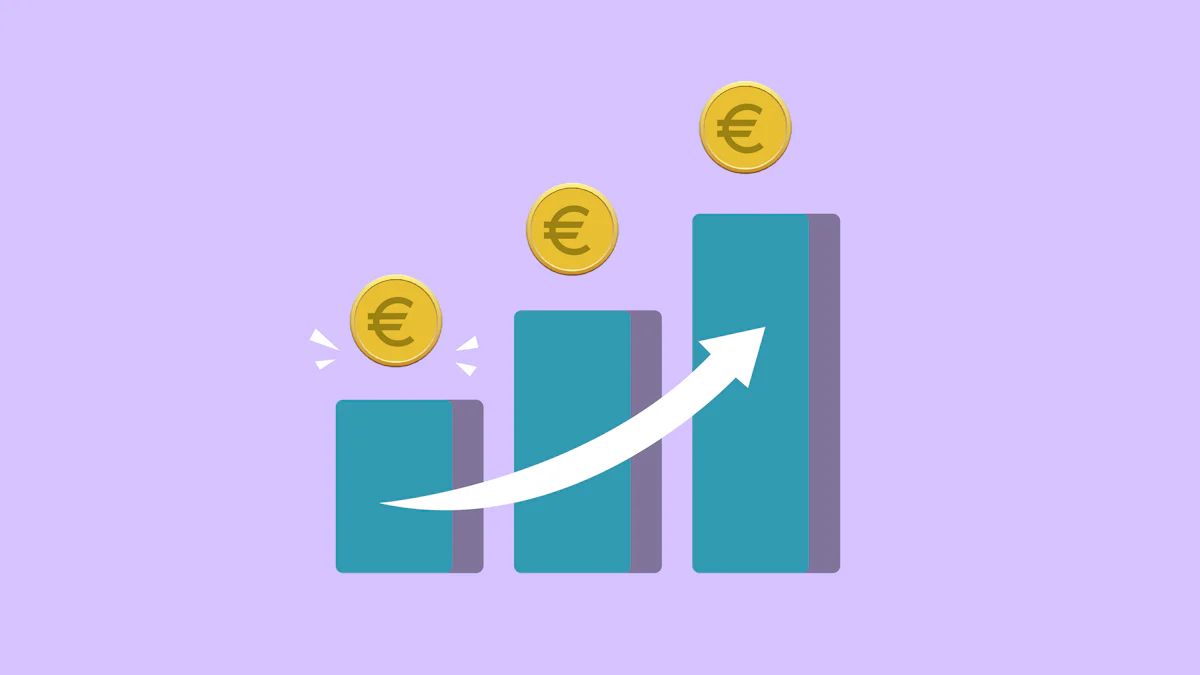Understanding Compound Interest: The Secret to Growing Your Wealth

Imagine your money working for you, growing steadily over time. This is the magic of compound interest. It allows you to earn interest not just on your initial savings but also on the interest that accumulates. Over time, this creates a snowball effect, turning small investments into substantial wealth.
Consider this: a $10,000 investment at a 7% annual interest rate grows to about $76,123 in 30 years with compound interest. Without it, the same investment would only reach $31,000. Starting early amplifies this effect. A 25-year-old investing $5,000 annually at a 7% return could have over $1 million by age 65. Waiting until 35 could cut that amount in half.
Understanding compound interest empowers you to take control of your financial future. It’s not just a concept; it’s the key to unlocking exponential growth and achieving long-term financial success.
Key Takeaways
Compound interest helps your money grow faster. It earns interest on both your starting amount and the interest added over time.
Investing early can grow your money a lot. For example, saving $200 each month at age 25 could become over $469,000 by age 65.
Putting your earnings, like dividends, back into your account makes your money grow even faster.
Adding money regularly is very important. Even small amounts can grow big over time.
Don’t wait to start investing. Starting now, even with little money, can greatly improve your future finances.
What Is Compound Interest?

The Basics of Compound Interest
Definition and how it works
Compound interest is the process of earning interest on both your original investment and the interest that accumulates over time. This concept, often called "interest on interest," creates a powerful snowball effect. The longer you let your money grow, the faster it multiplies.
The idea of compound interest has been around for centuries. Richard Witt's book Arithmeticall Questions in 1613 was one of the first works to focus entirely on this concept. Jacob Bernoulli later discovered the constant "e" in 1683 while studying compound interest. Even Persian merchants used early methods to calculate it in the 19th century. These historical milestones highlight its importance in shaping financial growth.
The formula explained simply
The formula for compound interest is straightforward:
A = P(1 + r/n)^(nt)
Here’s what it means:
A is the final amount.
P is your initial investment.
r is the annual interest rate (in decimal form).
n is the number of times interest compounds per year.
t is the time in years.
For example, if you invest $1,000 at a 5% annual interest rate, compounded monthly for 10 years, your money grows to $1,647. This formula shows how small contributions can lead to significant growth over time.
Compound Interest vs. Simple Interest
Key differences in growth
The difference between compound and simple interest lies in how they grow. Simple interest adds the same amount every year because it only calculates interest on the principal. Compound interest, however, grows faster because it calculates interest on both the principal and the accumulated interest.
A side-by-side example
Imagine you invest $1,000 at a 5% annual interest rate for 10 years:
With simple interest, your total grows to $1,500.
With compound interest, it grows to $1,628.89.
A graph comparing the two would show a straight line for simple interest and a curve for compound interest. The curve highlights the exponential growth of compound interest, demonstrating its ability to build wealth more effectively.
How Compound Interest Grows Wealth
A practical investment scenario
Let’s say you start investing $200 monthly at a 6% annual return when you’re 25. By age 65, you could have $393,700. If you wait until 35 to start, you’d only have $201,100. This example shows how starting early allows compound interest to work its magic over time.
The role of reinvested earnings
Reinvesting your earnings is crucial for maximizing compound interest. When you reinvest dividends or interest, you allow your money to grow on itself. This reinvestment accelerates the compounding process, turning small contributions into substantial wealth. Anne Scheiber, for instance, grew her savings to over $20 million by consistently reinvesting her earnings and staying patient.
Why Compound Interest Is Key to Wealth Growth

The Time Value of Money
Starting early and its impact
The time value of money shows how your money today can grow significantly over time. Mathematically, it’s represented as FV = PV (1 + i/n)^(n*t). This formula highlights how compound interest allows your savings to grow exponentially. Starting early gives you more time to benefit from this growth.
Consider Alice and Bob. Alice begins investing $200 monthly at age 25 and accumulates $469,000 by age 65. Bob starts at 35 and ends up with $241,000. The difference is staggering. Starting early gives your investments more time to grow, making a huge impact on your future wealth.
The exponential growth effect
Compound interest creates an "interest on interest" effect, leading to exponential growth. Jamie, for example, invests $2,000 yearly starting at age 20 and grows her savings to $183,967 by age 60. Taylor, who starts at 30, ends up with $122,708. This demonstrates how time amplifies the power of compounding, turning small contributions into substantial wealth.
Real-Life Applications of Compound Interest
Retirement accounts (e.g., 401(k), IRA)
Retirement accounts like 401(k) and IRAs are excellent tools for building wealth. They use compound growth to maximize your savings. By reinvesting returns, these accounts allow your earnings to generate additional returns. Starting early ensures you take full advantage of this growth, securing a comfortable retirement.
College savings plans
College savings plans, such as 529 accounts, also rely on compound interest. Regular contributions to these plans can grow significantly over time, helping you cover future education costs. Starting early reduces the financial burden later.
Reinvesting dividends in stocks
Reinvesting dividends in stocks is another way to harness compound interest. By reinvesting your earnings, you allow your investments to grow faster. This strategy accelerates wealth accumulation and strengthens your financial future.
The Importance of Consistency
Regular contributions and their effect
Consistency is key to maximizing compound interest. Even small, regular contributions can lead to significant growth. For instance, investing $1,000 annually for 30 years at an 8% return grows to over $237,000. Regular contributions keep your investments growing steadily, helping you achieve your financial goals.
Staying invested for the long term
Staying invested ensures you benefit fully from compound interest. Withdrawing early disrupts the compounding process and reduces your potential returns. Patience and commitment allow your investments to grow exponentially, building lasting wealth over time.
How to Leverage Compound Interest
Start Early and Automate Contributions
Benefits of starting young
Starting early gives your investments more time to grow through compound interest. The longer your money stays invested, the more it benefits from exponential growth. For example, Alice starts investing $200 monthly at age 25 and accumulates $469,000 by age 65. Bob, who starts at 35, ends up with only $241,000. This decade-long head start nearly doubles Alice's wealth. By starting young, you allow your savings to grow significantly over time, showcasing the true power of compounding.
Setting up automatic savings or investments
Automating your contributions ensures consistency in your investment journey. It eliminates emotional decision-making, which often leads to missed opportunities. Automation acts as a financial buddy, holding you accountable for regular contributions. It also maximizes dollar-cost averaging, helping you navigate market fluctuations. With automation, you reduce decision fatigue and free up mental energy for other priorities. This simple step keeps your savings on track and growing steadily.
Reinvest Earnings for Maximum Growth
The power of reinvesting dividends
Reinvesting dividends supercharges your compound interest strategy. Each reinvested dividend buys more shares, which generate additional income. Over time, this cycle enhances your overall returns. For long-term investors, this approach significantly boosts wealth accumulation. By consistently reinvesting, you allow your investments to grow exponentially, creating a powerful compounding effect.
Avoiding early withdrawals
Early withdrawals disrupt the compounding process and reduce your potential returns. Staying invested ensures your money continues to grow uninterrupted. Patience is key. The longer you keep your investments untouched, the more they benefit from compound interest. Avoiding withdrawals allows you to maximize your savings and achieve your financial goals faster.
Best Places to Benefit from Compound Interest
High-yield savings accounts
High-yield savings accounts offer a safe way to grow your money. For example, Quontic Bank provides an annual percentage yield (APY) of 4.5% as of January 2024. These accounts are ideal for short-term goals or emergency funds.
Retirement funds (e.g., 401(k), IRA)
Retirement accounts like 401(k)s and IRAs are excellent for long-term growth. They combine tax advantages with the power of compound interest. By reinvesting returns, these accounts help you build a substantial retirement fund over time.
Stock market and index funds
Investing in the stock market or index funds offers higher growth potential. Reinvesting dividends in these investments allows you to purchase more shares, increasing future returns. This strategy is particularly effective for long-term wealth building.
Avoiding Common Pitfalls
Delaying Investments
The cost of waiting too long
Procrastination can be one of the biggest obstacles to building your wealth. When you delay investing, you lose valuable time that could have allowed compound interest to work its magic. For example, starting your savings at 25 instead of 35 could mean doubling your final amount by retirement. The earlier you begin, the more time your money has to grow exponentially. Waiting too long reduces the potential for growth and makes it harder to reach your financial goals.
Overcoming procrastination
Taking the first step is often the hardest. Start small if you feel overwhelmed. Even a modest monthly contribution to your savings or investment account can make a difference. Automating your contributions can also help you stay consistent. Remember, the key is to start now. Every day you wait is a missed opportunity for your money to grow.
Overlooking Fees and Inflation
How fees erode returns
Fees may seem small, but they can significantly impact your returns over time. High fees reduce the benefits of compound interest and slow down your wealth-building journey. To avoid this, evaluate the fees associated with your investment options. Look for low-cost funds or accounts that align with your financial goals. Also, consider the tax implications of your investments to minimize your tax burden and maximize your returns.
Tip: Lower fees mean more of your money stays invested, allowing compound interest to work harder for you.
Adjusting for inflation in planning
Inflation reduces the purchasing power of your savings over time. If your investments don’t outpace inflation, you may struggle to meet your future financial needs. To combat this, choose investments with higher growth potential, such as stocks or index funds. These options can help your savings grow faster than inflation, ensuring your money retains its value in the long run.
Chasing Short-Term Gains
Risks of speculative investments
Speculative investments may promise quick returns, but they come with high risks. Chasing short-term gains often leads to losses, disrupting your financial progress. Compound interest thrives on stability and time, not on risky, short-term bets. Avoid gambling with your savings and focus on strategies that build wealth steadily.
Focusing on sustainable, long-term growth
Long-term strategies are the foundation of successful wealth-building. Start early and invest consistently to maximize compound interest. Reinvest your dividends and interest to accelerate growth. Minimize fees and taxes to enhance your returns. Diversify your portfolio to manage risk effectively. Finally, leverage tax-advantaged accounts like 401(k)s or IRAs to boost your savings. These sustainable approaches ensure your investments grow steadily and securely over time.
Compound interest holds the key to transforming your financial future. It accelerates wealth growth by compounding on both your principal and accumulated interest, creating exponential results over time. Starting early and staying consistent are your greatest allies. Even small, regular contributions can lead to life-changing outcomes.
Take action today. Begin investing, automate your savings, and reinvest your earnings. Time is your most valuable asset. The earlier you start, the more powerful the compounding effect becomes. Your financial goals are within reach—let compound interest guide you there.
Remember: Every dollar invested today is a step closer to financial freedom.
See Also
Recovering Financially: Strategies for Wealth After Challenges
Navigating Risk and Reward: Smart Investment Strategies
Understanding a Wealth-Building Mindset and Its Importance
Everyday Routines of Individuals Who Achieve Financial Success

